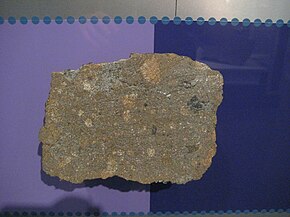Weston meteorite: Difference between revisions
m Reverted edits by 2A00:23C4:26E1:B000:51DB:8F53:A1DB:BED (talk): Editing tests (HG) (3.1.22) |
|||
| Line 27: | Line 27: | ||
==Debris field & Naming== |
==Debris field & Naming== |
||
The majority of the [[strewn field| |
The majority of the [[strewn field|strewn field]] (the area of debris field where the bulk of the meteorite fragments fell) is located in the eastern part of the present day town of [[Easton, Connecticut|Easton]] - in and around the Easton Reservoir.<ref name="LPS"/> Even though none of the [[strewn field|debris field]] is currently located in the town of Weston, the town of Easton was within and part of the town of Weston in 1807, hence the name ''Weston meteorite''. The remaining part of the debris field extended into the western part of neighboring [[Trumbull, Connecticut|Trumbull]]. Several fragments of this meteorite were collected in the Tashua section of [[Trumbull, Connecticut|Trumbull]], in and around what is now Sturbridge Lane and [http://www.tashuaknolls.com/ Tashua Knolls].<ref name="LPS"/> |
||
==Historical & Scientific Significance== |
==Historical & Scientific Significance== |
||
Revision as of 18:24, 30 March 2017
| Weston meteorite | |
|---|---|
 Weston meteorite, H4 | |
| Type | Chondrite |
| Class | Ordinary chondrite |
| Country | United States |
| Region | Weston, Connecticut |
| Observed fall | Yes |
| Fall date | 1807-12-14 |
The Weston meteorite is a meteorite which fell to earth above the town of Weston, Connecticut on December 14, 1807.[1]
History
The Weston meteorite is a meteorite which fell to earth above the town of Weston, Connecticut at approximately 6:30 in the morning on December 14, 1807.[1] The meteor fall was widely witnessed and reported in newspaper accounts at the time.[2] Eyewitnesses reported three loud explosions, and stone fragments fell in at least six locations.[3]
Debris field & Naming
The majority of the strewn field (the area of debris field where the bulk of the meteorite fragments fell) is located in the eastern part of the present day town of Easton - in and around the Easton Reservoir.[2] Even though none of the debris field is currently located in the town of Weston, the town of Easton was within and part of the town of Weston in 1807, hence the name Weston meteorite. The remaining part of the debris field extended into the western part of neighboring Trumbull. Several fragments of this meteorite were collected in the Tashua section of Trumbull, in and around what is now Sturbridge Lane and Tashua Knolls.[2]
Historical & Scientific Significance
Fragments from the fall were collected, documented, and chemically analyzed by Yale University professors Benjamin Silliman and James Kingsley. The Weston meteorite is the first meteorite to fall in the New World which was documented in such a manner, marking the beginning of meteorite science in the United States. Fragments of the meteorite remain within the Yale meteorite collection, which is the oldest such collection in the United States.[2]
